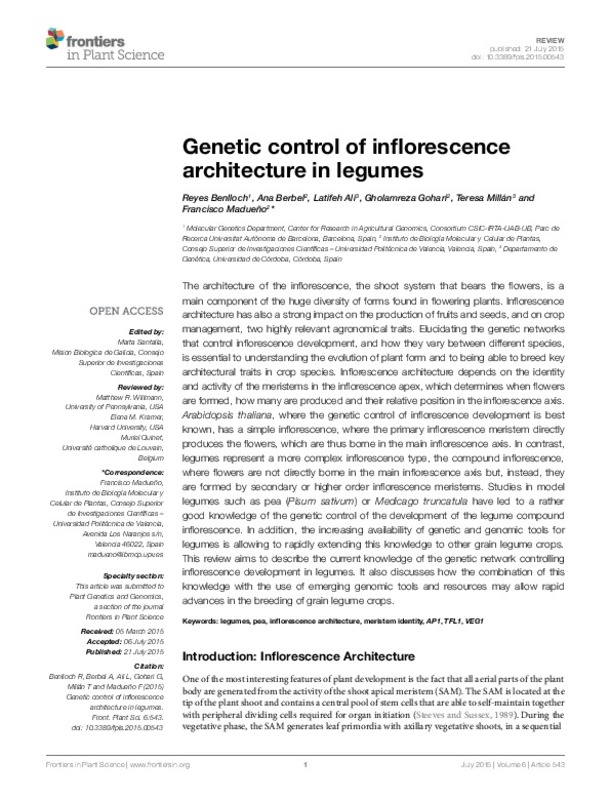JavaScript is disabled for your browser. Some features of this site may not work without it.
Buscar en RiuNet
Listar
Mi cuenta
Estadísticas
Ayuda RiuNet
Admin. UPV
Genetic control of inflorescence architecture in legumes
Mostrar el registro sencillo del ítem
Ficheros en el ítem
| dc.contributor.author | Benlloch, Reyes
|
es_ES |
| dc.contributor.author | Berbel Tornero, Ana
|
es_ES |
| dc.contributor.author | Ali, Latifeh
|
es_ES |
| dc.contributor.author | Gohari, Gholamreza
|
es_ES |
| dc.contributor.author | Millán, Teresa
|
es_ES |
| dc.contributor.author | Madueño Albi, Francisco
|
es_ES |
| dc.date.accessioned | 2016-07-22T10:27:20Z | |
| dc.date.available | 2016-07-22T10:27:20Z | |
| dc.date.issued | 2015-07-21 | |
| dc.identifier.issn | 1664-462X | |
| dc.identifier.uri | http://hdl.handle.net/10251/68029 | |
| dc.description.abstract | [EN] The architecture of the inflorescence, the shoot system that bears the flowers, is a main component of the huge diversity of forms found in flowering plants. Inflorescence architecture has also a strong impact on the production of fruits and seeds, and on crop management, two highly relevant agronomical traits. Elucidating the genetic networks that control inflorescence development, and how they vary between different species, is essential to understanding the evolution of plant form and to being able to breed key architectural traits in crop species. Inflorescence architecture depends on the identity and activity of the meristems in the inflorescence apex, which determines when flowers are formed, how many are produced and their relative position in the inflorescence axis. Arabidopsis thaliana, where the genetic control of inflorescence development is best known, has a simple inflorescence, where the primary inflorescence meristem directly produces the flowers, which are thus borne in the main inflorescence axis. In contrast, legumes represent a more complex inflorescence type, the compound inflorescence, where flowers are not directly borne in the main inflorescence axis but, instead, they are formed by secondary or higher order inflorescence meristems. Studies in model legumes such as pea (Pisum sativum) or Medicago truncatula have led to a rather good knowledge of the genetic control of the development of the legume compound inflorescence. In addition, the increasing availability of genetic and genomic tools for legumes is allowing to rapidly extending this knowledge to other grain legume crops. This review aims to describe the current knowledge of the genetic network controlling inflorescence development in legumes. It also discusses how the combination of this knowledge with the use of emerging genomic tools and resources may allow rapid advances in the breeding of grain legume crops. | es_ES |
| dc.description.sponsorship | Research in the Madueño lab is supported by grants form the Spanish Ministerio de Economía y Competitividad (BFU2012- 38929), the Generalitat Valenciana (ACOMP/2014/109) and the EU (LEGATO project, GA n◦FP7-613551) and in the Millán lab by the INIA (RTA2013-00025,co-financed by the EU, ERDF 2014-2020). RB is supported by a postdoctoral IE Marie-Curie Fellowship (FP7-PEOPLE-2011-IEF-299639-Molecular Clock) and LA by a Ph.D. fellowship from Syrian Ministry of High Education. | es_ES |
| dc.language | Inglés | es_ES |
| dc.publisher | Frontiers Media | es_ES |
| dc.relation.ispartof | Frontiers in Plant Science | es_ES |
| dc.rights | Reserva de todos los derechos | es_ES |
| dc.subject | Legumes | es_ES |
| dc.subject | Pea | es_ES |
| dc.subject | Inflorescence architecture | es_ES |
| dc.subject | Meristem identity | es_ES |
| dc.subject | AP1 | es_ES |
| dc.subject | TFL1 | es_ES |
| dc.subject | VEG1 | es_ES |
| dc.title | Genetic control of inflorescence architecture in legumes | es_ES |
| dc.type | Artículo | es_ES |
| dc.identifier.doi | 10.3389/fpls.2015.00543 | |
| dc.relation.projectID | info:eu-repo/grantAgreement/EC/FP7/613551/EU/LEGumes for the Agriculture of TOmorrow/ | es_ES |
| dc.relation.projectID | info:eu-repo/grantAgreement/MINECO//BFU2012-38929/ES/CONTROL DE LA FLORACION: LOS FACTORES DE TRANSCRIPCION VOZ COMO NUEVOS REGULADORES TRANSVERSALES DE LA RED GENETICA/ | es_ES |
| dc.relation.projectID | info:eu-repo/grantAgreement/GVA//ACOMP%2F2014%2F109/ | es_ES |
| dc.relation.projectID | info:eu-repo/grantAgreement/EC/FP7/299639/EU/Sumoylation: a regulatory mechanism for circadian clock function/ | |
| dc.relation.projectID | info:eu-repo/grantAgreement/MINECO//RTA2013-00025/ | es_ES |
| dc.rights.accessRights | Abierto | es_ES |
| dc.contributor.affiliation | Universitat Politècnica de València. Instituto Universitario Mixto de Biología Molecular y Celular de Plantas - Institut Universitari Mixt de Biologia Molecular i Cel·lular de Plantes | es_ES |
| dc.description.bibliographicCitation | Benlloch, R.; Berbel Tornero, A.; Ali, L.; Gohari, G.; Millán, T.; Madueño Albi, F. (2015). Genetic control of inflorescence architecture in legumes. Frontiers in Plant Science. 6(543):1-14. https://doi.org/10.3389/fpls.2015.00543 | es_ES |
| dc.description.accrualMethod | S | es_ES |
| dc.relation.publisherversion | http://dx.doi.org/10.3389/fpls.2015.00543 | es_ES |
| dc.description.upvformatpinicio | 1 | es_ES |
| dc.description.upvformatpfin | 14 | es_ES |
| dc.type.version | info:eu-repo/semantics/publishedVersion | es_ES |
| dc.description.volume | 6 | es_ES |
| dc.description.issue | 543 | es_ES |
| dc.relation.senia | 308383 | es_ES |
| dc.identifier.pmid | 26257753 | en_EN |
| dc.identifier.pmcid | PMC4508509 | en_EN |
| dc.contributor.funder | European Commission | |
| dc.contributor.funder | Ministerio de Economía y Competitividad | |
| dc.contributor.funder | Generalitat Valenciana | |
| dc.contributor.funder | European Regional Development Fund | es_ES |
| dc.contributor.funder | Ministry of Higher Education, Siria | es_ES |








